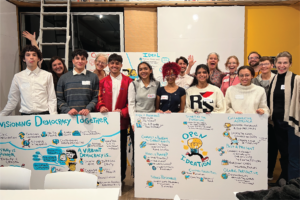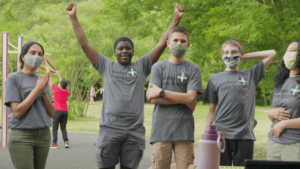How Do You Draw a Scientist?

What comes to mind when you think of a scientist? Try this: Make a list or draw a quick sketch of a scientist.
If the image of a wild-haired man in a white lab coat surrounded by test tubes comes to mind, you’re not alone. How many of the following features did you use?
- Lab coat (not necessarily white)
- Eyeglasses
- Facial hair (beards, mustaches, muttonchops, etc.)
- Scientific instruments or laboratory equipment
- Symbols of knowledge (books, filing cabinets, etc.)
- Technology (computers, buttons, dials, screens, etc.)
- Captions, signs, or speech bubbles expressing “eureka,” “top secret,” or similar
- White
- Male
The “Draw a Scientist” test is a classic study from the 1970s that asked high school students to do just that. The authors, Mead and Metraux, then sorted through students’ drawings to look for commonalities. Their composite image?
“The scientist is a man who wears a white coat and works in a laboratory. He is elderly or middle aged and wears glasses . . . he may wear a beard. . . he is surrounded by equipment: test tubes, bunsen burners, flasks and bottles, a jungle gym of blown glass tubes and weird machines with dials . . . One day he may straighten up and shout: “I’ve found it! I’ve found it!” (Mead and Metraux, 1975).
Additionally, only girls drew women scientists, and scientists are almost always drawn indoors in a lab or even an underground bunker.
The original “Draw a Scientist” test and its many follow-up studies have suggested that scientists suffer from a public image problem among children as young as kindergartners.
When instructed to “draw another scientist,” one fourth grade class of 24 students produced “two Frankensteins along with nine pictures that included such clearly dangerous elements as bombs, poisons, and a scientist with test tube held high exclaiming: ‘With this I destroy the world’! … The result was totally unexpected since the intention of this variation in procedure had been to elicit possible distinctions among scientific specialties. In fact, no such distinctions were clearly found” (Chambers 1983). In another study, students were asked to draw a teacher, a veterinarian, and a scientist in order to determine if the stereotypical scientist images were a product of children’s drawing abilities or habits. The result: scientists are typically male and less attractive (crazy, unsmiling, etc.) than veterinarians or teachers (Losh, Wilke, and Pop 2008). Losh, Wilke, and Pop caution against reading too much into the “Draw a Scientist” studies, given that young children may not be capable of drawing details (that might indicate a female rather than a male scientist, or that might add dimension to an otherwise stereotypical character), but they conclude: “Cumulatively, the research results suggest that scientists suffer from a ‘poor public image’; one consequence is that these images may discourage children and youth from choosing science classes, hobbies, or even careers.”
Scientists’ image problem extends to adults.
While a majority of American adults (69%) say that the benefits of scientific research outweigh harmful results, Americans also say that scientific work is dangerous (52%) and that scientists have no fun (20%) and are “odd and peculiar” (25%), according to studies from the National Science Foundation. The media is full of unflattering stereotypes of scientists, and even teachers will tend to draw stereotypical pictures of scientists. These stereotypes can filter down to children: “Classic scientist stereotypes may lead youngsters to see science as valuable—but science occupations and scientists as less desirable” (Losh, Wilke, and Pop 2008).
The good news is that stereotypical images of scientists aren’t set in stone.
Pre-service teachers who have experience with science and students who visit real scientists or engage in hands-on inquiry activities tend to draw less stereotypical images of scientists. Milford and Tippett studied the impact of prior science experience on stereotypes of scientists and concluded that it can be addressed “through a range of interventions that include science activities and experiences that begin in elementary school and continue throughout teacher education programs. Interventions at the elementary classroom level include visiting female scientists and hands-on inquiry activities, while interventions at the university level would seem to include a degree requirement for entry into an education program. Once in an education program, students should have opportunities to reflect on their conceptions of science and scientists” (Milford and Tippett 2012).
Scientists are people, too.
If you’re wondering how to involve some real science and real scientists in your classroom, remember: scientists are people, too. They often have hobbies, kids, and an interest in sharing what they’re passionate about. Getting a scientist in your classroom can be as easy as asking around. If you live near a city, tech companies and universities are obvious places to look, but even rural areas often have scientists hiding in the local Fish and Wildlife Service, National Park Service, or Bureau of Land Management. Get creative – try Skype or find scientists who happen to be in your area for seasonal fieldwork or conferences. The added benefit of connecting with local scientists is that you get to learn about all the great science going on in your own backyard – whether it’s discovering T. rex fossils in Montana or learning what makes the Everglades so special in Florida.
As for activities, there are nearly unlimited inquiry-based science activities to be found online. Try PBS, Teach the Earth (geosciences), NASA, Federal Resources for Educational Excellence, University of California at Berkeley’s Teacher Lounge, and the National Science Teachers Association.







0 Comments
Leave a Comment
Your email address will not be published. All fields are required.